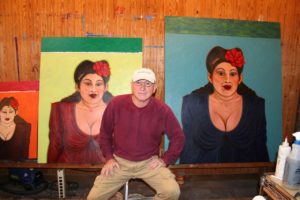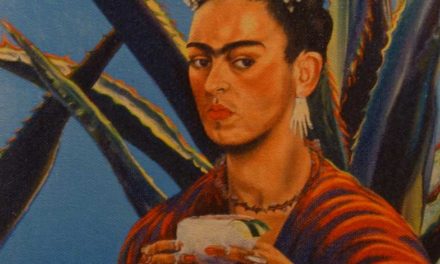By Ricardo Romo
Cesar Martinez grew up in Laredo, Texas and attended Texas A&M University at Kingsville. While at the Kingsville campus he formed friendships with several Latino artists who like himself, expressed in their paintings and drawings their own South Texas experience.
 Together these South Texas artists constituted the early creative developers of the Chicano art movement. These artists included Carmen Lomas Garza, Santa Barraza, Amado Pena, and Jose Rivera. After graduation, Martinez moved to San Antonio, Texas where he joined San Antonio College art professor and artist Mel Casas in forming the famed Con Safos art group. Con Safos is widely considered the first Chicano art organization in Texas. Martinez’ borderland environment greatly influenced his early artistic subjects. As a young teen Martinez crossed the border nearly every weekend to visit family, shop at the Gran Mercado (an open market that dated back to the 19th century), as well as attend bullfights at the Plaza de Toros. In some of his early works, Martinez painted a jaguar, which represented Pre-Columbian Indigenous culture, in confrontation with a bull, which represented the Spanish newcomers to Mexico.
Together these South Texas artists constituted the early creative developers of the Chicano art movement. These artists included Carmen Lomas Garza, Santa Barraza, Amado Pena, and Jose Rivera. After graduation, Martinez moved to San Antonio, Texas where he joined San Antonio College art professor and artist Mel Casas in forming the famed Con Safos art group. Con Safos is widely considered the first Chicano art organization in Texas. Martinez’ borderland environment greatly influenced his early artistic subjects. As a young teen Martinez crossed the border nearly every weekend to visit family, shop at the Gran Mercado (an open market that dated back to the 19th century), as well as attend bullfights at the Plaza de Toros. In some of his early works, Martinez painted a jaguar, which represented Pre-Columbian Indigenous culture, in confrontation with a bull, which represented the Spanish newcomers to Mexico.
Martinez considers himself a Mestizo, a blend of Indian and European cultures, an identity commonly accepted by Mexicans. In a well known self portrait, his facial features are divided: one half features a jaguar, while the opposite half is that of a bull.
Martinez is probably best known for his “Bato” or “Pachuco” series. In his “El Pantalon Rosa” (1984), Martinez captures the essence of an iconic figure from his barrio in Laredo at a time when “Pachuquismo” was in vogue in many of the borderland barrios. The community had several names for these stylish youth, including “Cholos” and “Chucos.” The later term was a shortening of “Pachuco” and seemed to originate in El Paso.
Looking carefully at the full range of Martinez’ work, we find that not all his subjects fall into this category. As he explained to me, the source of many of his visual images of men and women come from dusty old high school yearbooks of the 1940s and 1950s and even the obituary pages of his hometown.
Martinez is a prime interpreter of what it means to live in a society strongly influenced by Mexican, American, and border culture. His well known paintings include portraits of faith healer Pedro Jaramillo, bull fighters, and the Virgen de Guadalupe.
Martinez’s solo exhibition at the McNay Museum of San Antonio in 1999 was the first ever by a Latino. He has been included in CARA: Chicano Art: Resistance and Affirmation 1965-1985, organized by the Smithsonian Institute; and Hispanic Art in the United States, The Museum of Fine Arts, Houston. He has also shown at the Mexican Fine Arts Museum, Chicago; Museo de Arte Moderno, Mexico City; and the Contemporary Arts Museum, Houston.









